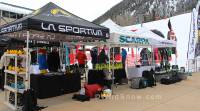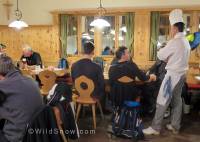
Uphill festivals such as this one in Aspen tend to be associated with races. I’m pushing for festivals more oriented to newcomers rather than emphasis on racing.
Where is the “uphill ski capitol” of the United States? Is it Jackson Hole with its abundant sidecountry gates and super accessible backcountry terrain? Or is it Salt Lake City with a giant population center close to the amazing Wasatch, along with a vibrant local’s race series? Well, right here in the Roaring Fork Valley, home of Wildsnow HQ, Aspen is making a hard play to put their city at the top of the list.
As co-owner of Cripple Creek Backcountry (just a short drive from Aspen) I had an obvious vested interest in attending a TAC (Technical Advisory Committee) hosted by Aspen city officials a few weeks ago. The plan: brainstorm steps to make Aspen not just a destination for the rich and famous, but an exceptional place for skiers who enjoy going the wrong way.
The city of Aspen and the Aspen Skiing Company (known locally as the “Skico” and branded as “Aspen Snowmass”) are already in a unique place for uphill traffic. The four Skico mountains as well as nearby Sunlight resort have been incredibly accommodating to uphill traffic: designated, uphill routes at Buttermilk and Highlands ski areas, an open range policy at Snowmass and Sunlight resorts (at all times of day) combine with a local population that loves motoring uphill.
It’s common to see 200 skiers climbing these mountains, especially Buttermilk, and a day’s total uphill traffic can trend into the thousands! These resorts are also home to the famed Power of Four ski mountaineering race and the finish line for the Grand Traverse, two of the largest “ski touring” races in the country.
With all these features going for the Roaring Fork Valley, it is no wonder that mayor Steve Skadron wants to make it official. The city of Aspen gathered local providers of ski touring gear, guides, athletes and of course representatives from the local ski mountains to be led by RRC Associates, a market research firm out of Boulder CO, to brainstorm the next steps in this uphill evolution.
The Goals
Bring the companies that define the sport to Aspen for product R&D and perhaps even manufacturing.
Enhance our uphilling infrastructure to easily accommodate increased traffic.
Provide a unique experience and more entry points for the new uphill skier.
The Challenges
The first challenge we discussed was what to call the sport. This has been a battle within the industry for years. How do you define the fastest growing part of the ski industry without being exclusive or limiting? “Backcountry skiing” or “ski mountaineering” are not accurate, and they intimidate the entry level uphiller. “Ski Touring” is a term used worldwide but English speakers tend to associate it with backcountry, though in Europe people will tell you they “ski toured” up the resort. In my opinion, “uphilling” is the term that could be the most accurate for in-resort or sidecountry uphill traveling on skis (with the additional benefit of keeping the concept open for folks who hike without skis, a common occurrence at resorts with dense “walkable” snowpacks). Clearly, the nomenclature is evolving.
Regarding the business location component of the goals above, it’s obvious the high rent district of Aspen Colorado is inappropriate for a ski gear distribution or manufacturing business. I suppose if the political will existed, the wealthy Aspen government could put together an incentive package that was impossible to refuse. But I don’t see that happening in reality. It’s too controversial for a town that’s often mired in controversy anyway.
The greater “Aspen” area, however, does have a few places where costs are more reasonable, located “downvalley” on Interstate Highway 70. Problems with those areas are many, for example a small potential employee pool and the challenge of relocating personnel from the city to rural western Colorado. Perhaps most importantly, the vast majority of ski companies are based in Europe and their distribution centers here in North America are located to be expedient — not because of nearby uphilling or how cool the town is. Likewise, most R&D is done near home offices. Examples being Salewa in Europe working out of the cities of Munich and Bolsano, and G3 in Canada having their strong connection between Vancouver and Nelson.
Barrier to entry for beginners is a challenge in the sport of “snow uphilling.” This was particularly obvious when we assembled our all-star advisory committee of guides, shop owners and elite athletes to do the planning. Most of us are heavily involved in working with newcomers to the sport, and their numerous issues varying from cost to safety. In terms of existing amenities for beginners, Aspen Mountain has an incredible lodge, the Sundeck, at the top of a mere 3300 foot climb. As fun as it would be to have uphilling dinners at the summit, that is no stroll for someone new to ski touring. Buttermilk has a better situation with their summit restaurant on top of a reasonable climb, they’ve already been experimenting with successful night dinners for uphillers. We’d like to see that trend continue.

This resturant in Austria does more than 600 plates at night, for uphill skiers. Mutterer Alm chef making sure his guests are happy. The food is excellent, with average prices. One assumes that the sheer volume of business makes for a successful business endeavor. In my opinion, could happen here with the right mix of location and menu.
Caveats with on-mountain restaurant services for night uphill skiing are of course many. Perhaps the biggest concern is guests being over-served with alcohol then being involved in an accident when they ski down. At first glance, that might seem like a serious obstacle. Actually, it’s not. Restaurants have been dealing with this issue for years. Specifically, on-mountain restaurants have thousands of guests who drink and ski during the day. Dealing with that at night shouldn’t be a big deal.
As always, to get full cooperation from the powers that be, there needs to be a way to monetize an activity that will require added infrastructure and resources to enhance to experience for all. Charging for an uphill pass, or added food and beverage sold through before and after hours skinning could help this. Restaurants in Europe that cater to uphilling can actually do quite well, perhaps that’s part of the solution here. All considered, everything from tickets to meals seem like a drop in the bucket when lift tickets are closing in on $200 a day, but a well managed “guest” oriented business is more successful when it gives guests what they want. Perhaps that’s the compensation.
At the meeting, I suggested developing uphill single-track trails that will give uphillers an alternative route up the mountain rather than just pounding groomers. Over past years, I’ve heard others voice this goal as well. These runs could use the same green, blue, black rating system of the downhill crowd with blacks having steeps with mandatory kickturns and possible booters. Special uphill routes would also relieve some of the stress that having hundreds of skiers going the wrong way on the mountain and the impending collisions that are bound to happen.
Another idea: An uphill festival separate from the competitive race oriented ones that have become the standard. Every race I attend has only a dozen locals out of the thousand that own skinning equipment that make it out. The non-competitive festival could welcome hundreds of new people into an amazing sport.
This was the first round of brainstorming so it remains to be seen what a true actionable plan will be, but some very cool ideas were tossed around. Whatever becomes of Aspen’s uphill initiative, it is an amazing step to bring guides, local business owners, the city government and of course the mountain together in one room to talk about the challenges of this growing sport.
(Wildsnow guest blogger Doug Stenclik is co-owner of Cripple Creek Backcountry, the Wildsnow “hometown” ski shop. This winter of 2016-2017 we’re partnering with Doug to publish a variety of uphill skiing and general “shop perspective” ski touring articles that will broaden the scope of WildSnow.com.)
Doug Stenclik is an avid skimo racer and ski mountaineer who lives for sharing the amazing sports of ski touring and splitboarding. Since his first time on skins he was hooked and the obsession has taken him all over the United States and the world pursuing the human powered ski turn. He founded Cripple Creek Backcountry in 2012 and took over the Colorado Ski Mountaineering Race Cup in 2014 to spread knowledge and the love of the sport. In 2019 he took a step back from the ski shop and race promoter life to become a publishing partner with WildSnow.
